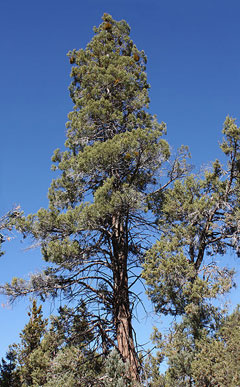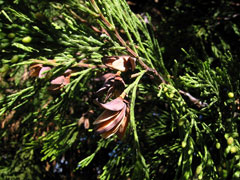 |
|
http://www.flickr.com/people/85979850@N00 |
 |
| http://en.wikipedia.org/wiki/User_talk:Wsiegmund |
Translate this page:
Summary
Bloom Color: Unknown.
Main Bloom Time: Early spring, Late spring, Mid spring. Form: Columnar, Pyramidal.
Physical Characteristics

 Calocedrus decurrens is an evergreen Tree growing to 15 m (49ft) by 2 m (6ft) at a slow rate.
Calocedrus decurrens is an evergreen Tree growing to 15 m (49ft) by 2 m (6ft) at a slow rate.
See above for USDA hardiness. It is hardy to UK zone 7. It is in leaf all year, in flower in May, and the seeds ripen from September to October. The species is monoecious (individual flowers are either male or female, but both sexes can be found on the same plant) and is pollinated by Wind.
Suitable for: light (sandy), medium (loamy) and heavy (clay) soils and prefers well-drained soil. Suitable pH: mildly acid, neutral and basic (mildly alkaline) soils. It can grow in semi-shade (light woodland) or no shade. It prefers dry or moist soil.
UK Hardiness Map
US Hardiness Map
Synonyms
Heyderia decurrens. Libocedrus decurrens. Thuja gigantea. non Nutt.
Plant Habitats
Woodland Garden Canopy; Secondary;
Edible Uses
Edible Parts:
Edible Uses: Condiment
The dense leaflets have been used as a flavouring and protection when leaching acorns[257].
References More on Edible Uses
Medicinal Uses
Plants For A Future can not take any responsibility for any adverse effects from the use of plants. Always seek advice from a professional before using a plant medicinally.
Miscellany Stomachic
A decoction of the leaves has been used to treat stomach troubles[257]. Steam from an infusion of the leaves has been inhaled in the treatment of colds[257].
References More on Medicinal Uses
The Bookshop: Edible Plant Books
Our Latest books on Perennial Plants For Food Forests and Permaculture Gardens in paperback or digital formats.

Edible Tropical Plants
Food Forest Plants for Hotter Conditions: 250+ Plants For Tropical Food Forests & Permaculture Gardens.
More

Edible Temperate Plants
Plants for Your Food Forest: 500 Plants for Temperate Food Forests & Permaculture Gardens.
More

More Books
PFAF have eight books available in paperback and digital formats. Browse the shop for more information.
Shop Now
Other Uses
Basketry Broom Containers Miscellany Wood
The boughs and twigs have been used to make brooms[257]. The roots have been used as overlay twine warps and overlay twine weft bases in making baskets[257]. The bark has been made into baskets[257]. Wood - soft, light, close grained, very durable in the soil though it is often damaged by dry rot[82]. It has a powerful, incense-like fragrance[245] and is used for making shingles, lathes, fencing, pencils, construction etc[46, 61, 81, 171]. Mature trees are often infected by dry rot, so they are not considered to be a major timber species[229].
Special Uses
Scented Plants
References More on Other Uses
Cultivation details
Landscape Uses:Pest tolerant, Screen, Specimen. Succeeds in full sun in a moist well-drained soil that is neutral to acid, though it will also survive on dry alkaline soils[200]. Plants are shade tolerant when young[200]. It grows best in a position that is sheltered from strong winds[245]. Trees are slow growing but long-lived in the wild, with specimens up to 1000 years old recorded[229]. They grow slowly in Britain, but they are perfectly hardy[11]. Young trees can grow 60cm in a year but they seldom average more than 30cm[185]. Growth virtually stops once the tree reaches 25 metres tall[185]. All parts of the plant are strongly aromatic[188, 245]. This species is strongly resistant to honey fungus[81, 188]. The tree exhibits very different crown habits dependant upon the area in which it is being grown[185, 200]. At one time these different habits were considered to be different sub-species, but it is recognised now that it is only climatic forces that cause the differences. Special Features:
North American native, Fragrant foliage, Inconspicuous flowers or blooms.
References Carbon Farming Information and Carbon Sequestration Information
Temperature Converter
Type a value in the Celsius field to convert the value to Fahrenheit:
Fahrenheit:
The PFAF Bookshop
Plants For A Future have a number of books available in paperback and digital form. Book titles include Edible Plants, Edible Perennials, Edible Trees,Edible Shrubs, Woodland Gardening, and Temperate Food Forest Plants. Our new book is Food Forest Plants For Hotter Conditions (Tropical and Sub-Tropical).
Shop Now
Plant Propagation
Seed - sow early spring in a greenhouse[245]. When large enough to handle, prick the seedlings out into individual pots and grow them on in light shade in a greenhouse or cold frame for their first winter. Plant them out in late spring or early summer, after the last expected frosts and consider giving them some protection from the cold for their first winter outdoors. Cuttings of the current season's growth, taken in mid autumn, in a light sandy soil in a cold frame[245].
Other Names
If available other names are mentioned here
Native Range
NORTHERN AMERICA: United States (Oregon (west), California, Nevada (west)), Mexico (Baja (north))
Weed Potential
Right plant wrong place. We are currently updating this section.
Please note that a plant may be invasive in one area but may not in your area so it's worth checking.
Conservation Status
IUCN Red List of Threatened Plants Status :

Growth: S = slow M = medium F = fast. Soil: L = light (sandy) M = medium H = heavy (clay). pH: A = acid N = neutral B = basic (alkaline). Shade: F = full shade S = semi-shade N = no shade. Moisture: D = dry M = Moist We = wet Wa = water.
Now available:
Food Forest Plants for Mediterranean Conditions
350+ Perennial Plants For Mediterranean and Drier Food Forests and Permaculture Gardens.
[Paperback and eBook]
This is the third in Plants For A Future's series of plant guides for food forests tailored to
specific climate zones. Following volumes on temperate and tropical ecosystems, this book focuses
on species suited to Mediterranean conditions—regions with hot, dry summers and cool, wet winters,
often facing the added challenge of climate change.
Read More
Expert comment
Author
(Torr.)Florin.
Botanical References
1160200
Links / References
For a list of references used on this page please go here
Readers comment